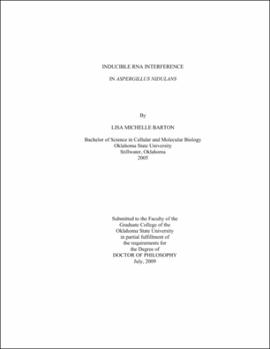| dc.contributor.advisor | Prade, Rolf | |
| dc.contributor.author | Barton, Lisa Michelle | |
| dc.date.accessioned | 2013-11-26T08:22:48Z | |
| dc.date.available | 2013-11-26T08:22:48Z | |
| dc.date.issued | 2009-07 | |
| dc.identifier.uri | https://hdl.handle.net/11244/6633 | |
| dc.description.abstract | Scope and Method of Study: | |
| dc.description.abstract | A unique RNAi construct was tested with the developmental gene, brlAB, in the fungal genetic model, Aspergillus nidulans. The construct contains inverted repeats of the inducible alcohol dehydrogenase (alcA) promoter surrounding a unique BamHI restriction enzyme site containing any gene of interest. The RNAi construct was utilized to generate a genome-wide RNAi library. The RNAi library was used here to screen for fludioxonil resistance. There is evidence that fludioxonil, a commonly used fungicide, activates an osmotic stress-signaling pathway. When it is aberrantly activated, the cells swell beyond capacity, leak their contents, and die. Ambruticin is an antifungal that could potentially be used in humans and animals to treat fungal infections, and it is also thought to aberrantly activate the osmotic stress-signaling pathway. The RNAi library strains resistant to fludioxonil were tested against ambruticin VS3 and sensitivity to osmotic stress. The silenced insert from selected strains was rescued from the genome by PCR of the integrated RNAi construct and sequenced to identify the silenced gene. Those genes that were identified more than one time were further analyzed in silico, and selected genes were chosen to independently confirm resistance conferred by silencing. | |
| dc.description.abstract | Findings and Conclusions: | |
| dc.description.abstract | The RNAi construct was found to integrate into the genome of the fungus and cause locus specific silencing of brlAB in Aspergillus nidulans. The RNAi strains had inducible brlA phenotypes, and downregulation of brlA was confirmed by Northern blotting and Real-Time Reverse-Transcriptase PCR. The downregulation of brlA was found to be induced by RNAi with anti-sense Northern blots and siRNA Northern blots, and the silencing was specific for brlAB, not brlAa, a downstream alternate transcript of the brlA locus. | |
| dc.description.abstract | Thirty-six genes were found more than one time to cause resistance to fludioxonil and ambruticin when silenced. Twenty-four of these had annotations, while twelve were hypothetical. Twenty-one out of the twenty-four annotated genes contain transmembrane domains, indicating that fludioxonil and ambruticin alter the plasma membrane in order to aberrantly activate the osmotic stress-signaling pathway. It also suggests there are multiple ways the drugs act upon the cell, rather that having a single target. | |
| dc.format | application/pdf | |
| dc.language | en_US | |
| dc.rights | Copyright is held by the author who has granted the Oklahoma State University Library the non-exclusive right to share this material in its institutional repository. Contact Digital Library Services at lib-dls@okstate.edu or 405-744-9161 for the permission policy on the use, reproduction or distribution of this material. | |
| dc.title | Inducible RNA interference in Aspergillus nidulans | |
| dc.contributor.committeeMember | Ayoubi, Patricia | |
| dc.contributor.committeeMember | Hadwiger, Jeffrey | |
| dc.contributor.committeeMember | Marek, Stephen | |
| dc.contributor.committeeMember | Shaw, Edward | |
| osu.filename | Barton_okstate_0664D_10418.pdf | |
| osu.accesstype | Open Access | |
| dc.type.genre | Dissertation | |
| dc.type.material | Text | |
| dc.subject.keywords | ambruticin antifungal | |
| dc.subject.keywords | aspergillus nidulans | |
| dc.subject.keywords | brla development | |
| dc.subject.keywords | fludioxonil fungicide | |
| dc.subject.keywords | osmotic stress | |
| dc.subject.keywords | rna interference | |
| thesis.degree.discipline | Microbiology, Cell and Molecular Biology | |
| thesis.degree.grantor | Oklahoma State University | |
